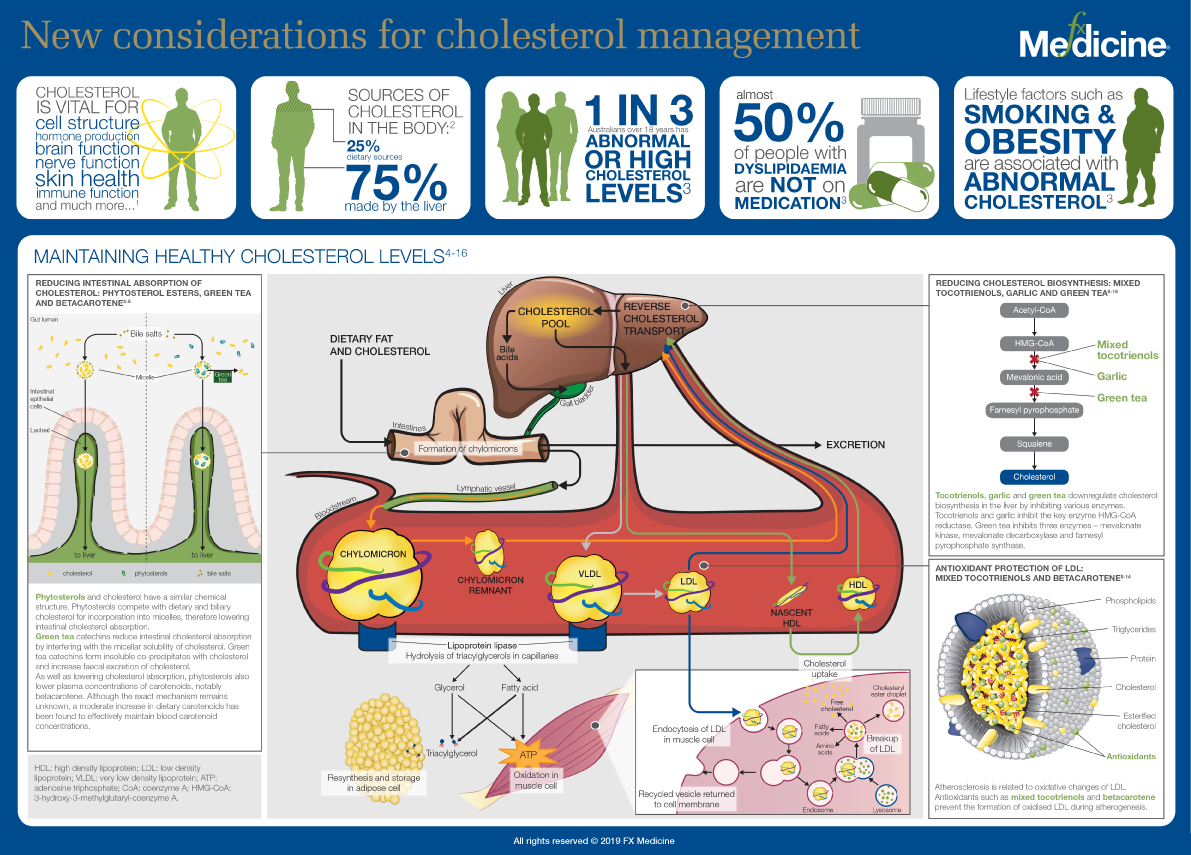
1 in 3 Australians over the 18 years old has abnormal or high cholesterol levels. Dyslipidaemia is one of the major risk factors for the development of cardiovascular disease. Certain nutrients and functional foods help improve serum lipid profiles by reducing total cholesterol (TC), triglyceride and low-density lipoprotein (LDL), while elevating high-density lipoprotein (HDL). The effectiveness of phytosterols, green tea catechins, garlic, tocotrienols and betacarotene in the management of dyslipidaemia has been clearly demonstrated in epidemiological and interventional trials. In addition, this integrative approach may also reduce inflammation, oxidative stress and immune responses.
In this infographic explore the mechanisms of action in support of a nutraceutical approach to cholesterol management.
RESEARCH
- Buist B. Love your cholesterol. Integrative Therapies Pty Ltd, 2014.
- Carrington MJ, Stewart S. Australia’s cholesterol crossroads: an analysis of 199,331 GP patient records. Baker IDI, Melbourne, Australia, 2011. [PDF]
- Australian Bureau of Statistics. 4364.0.55.005 - Australian health survey: biomedical results for chronic diseases, 2011-12. Viewed 23 Feb 2015, http://www.abs.gov.au/ausstats/abs@.nsf/Lookup/4812278BC4B8FE1ECA257BBB001217A4?opendocument
- Heggen E, Granlund L, Pedersen JI, et al. Plant sterols from rapeseed and tall oils: effects on lipids, fat-soluble vitamins and plant sterol concentrations. Nutr Metab Cardiovasc Dis 2010;20(4):258-265. [Abstract]
- Wu T, Fu J, Yang Y, et al. The effects of phytosterols/stanols on blood lipid profiles: a systematic review with meta-analysis. Asia Pac J Clin Nutr 2009;18(2):179-186. [Abstract]
- Brown AW. Mechanisms of decreased cholesterol absorption mediated by phytosterols in the intestinal lumen 2011. Nutrition & health sciences dissertations & theses. Viewed 23 Feb 2015, http://digitalcommons.unl.edu/nutritiondiss/19
- Ikeda I. Multifunctional effects of green tea catechins on prevention of the metabolic syndrome. Asia Pac J Clin Nutr 2008;17(S1):273-274. [PDF]
- Zheng XX, Xu YL, Li SH, et al. Green tea intake lowers fasting serum total and LDL cholesterol in adults: a meta-analysis of 14 randomized controlled trials. Am J Clin Nutr 2011;94(2):601-610. [Full text]
- Ge H, Liu J, Zhao W, et al. Mechanistic studies for tri-targeted inhibition of enzymes involved in cholesterol biosynthesis by green tea polyphenols. Org Biomol Chem 2014;12(27):4941-4951. [Abstract]
- Chin SF, Ibahim J, Makpol S, et al. Tocotrienol rich fraction supplementation improved lipid profile and oxidative status in healthy older adults: a randomised controlled study. Nutr Metab 2011;8(1):42. [Full text]
- Zhang PY, Xu X, Li XC. Cardiovascular diseases: oxidative damage and antioxidant protection. Eur Rev Med Pharmacol Sci 2014;18(20):3091-3096. [PDF]
- Jha P, Flather M, Lonn E, et al. The antioxidant vitamins and cardiovascular disease. A critical review of epidemiologic and clinical trial data. Ann Intern Med 1995;123(11):860-872. [Abstract]
- Rasool AH, Yuen KH, Yusoff K, et al. Dose dependant elevation of plasma tocotrienol levels and its effect on arterial compliance, plasma total antioxidant status, and lipid profile in healthy humans supplemented with tocotrienol rich vitamin E. J Nutr Sci Vitaminol 2006;52:473-478. [PDF]
- Wong RS, Radhakrishnan AK. Tocotrienol research: past into present. Nutr Rev 2012;70(9):483-490. [Abstract]
- Garlic monograph. Natural health products ingredients database, Health Canada 2014. Viewed 23 Feb 2015, http://webprod.hc-sc.gc.ca/nhpid-bdipsn/atReq.do?atid=garlic_ail&lang=eng
- Garlic. Natural Medicines Comprehensive Database 2014. Viewed 23 Feb 2015, www.naturaldatabase.com
This image by FX Medicine is licensed under a Creative Commons Attribution-NonCommercial-NoDerivatives 4.0 International License.
More information about how to share/use the infographics for personal use.
If you interested in using any FX Medicine content for commercial use please contact us.
DISCLAIMER:
The information provided on FX Medicine is for educational and informational purposes only. The information provided on this site is not, nor is it intended to be, a substitute for professional advice or care. Please seek the advice of a qualified health care professional in the event something you have read here raises questions or concerns regarding your health.




